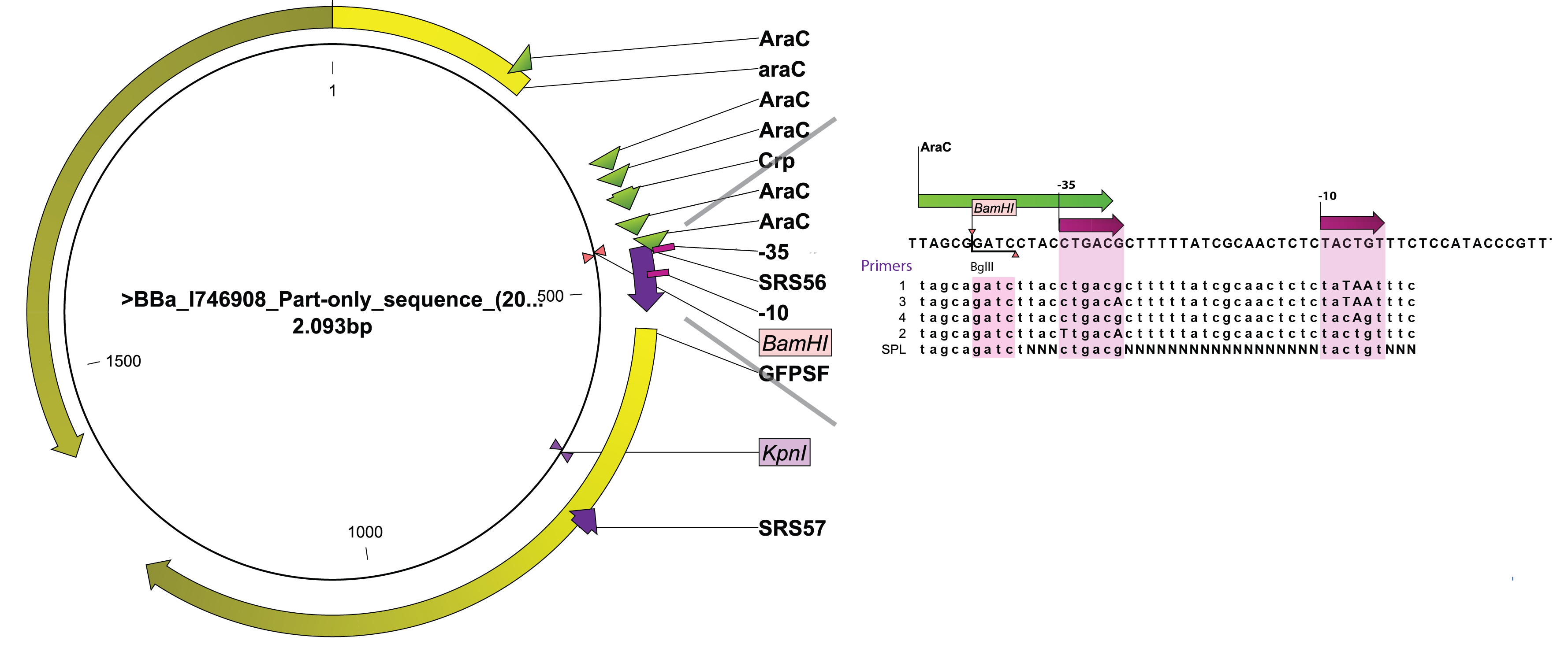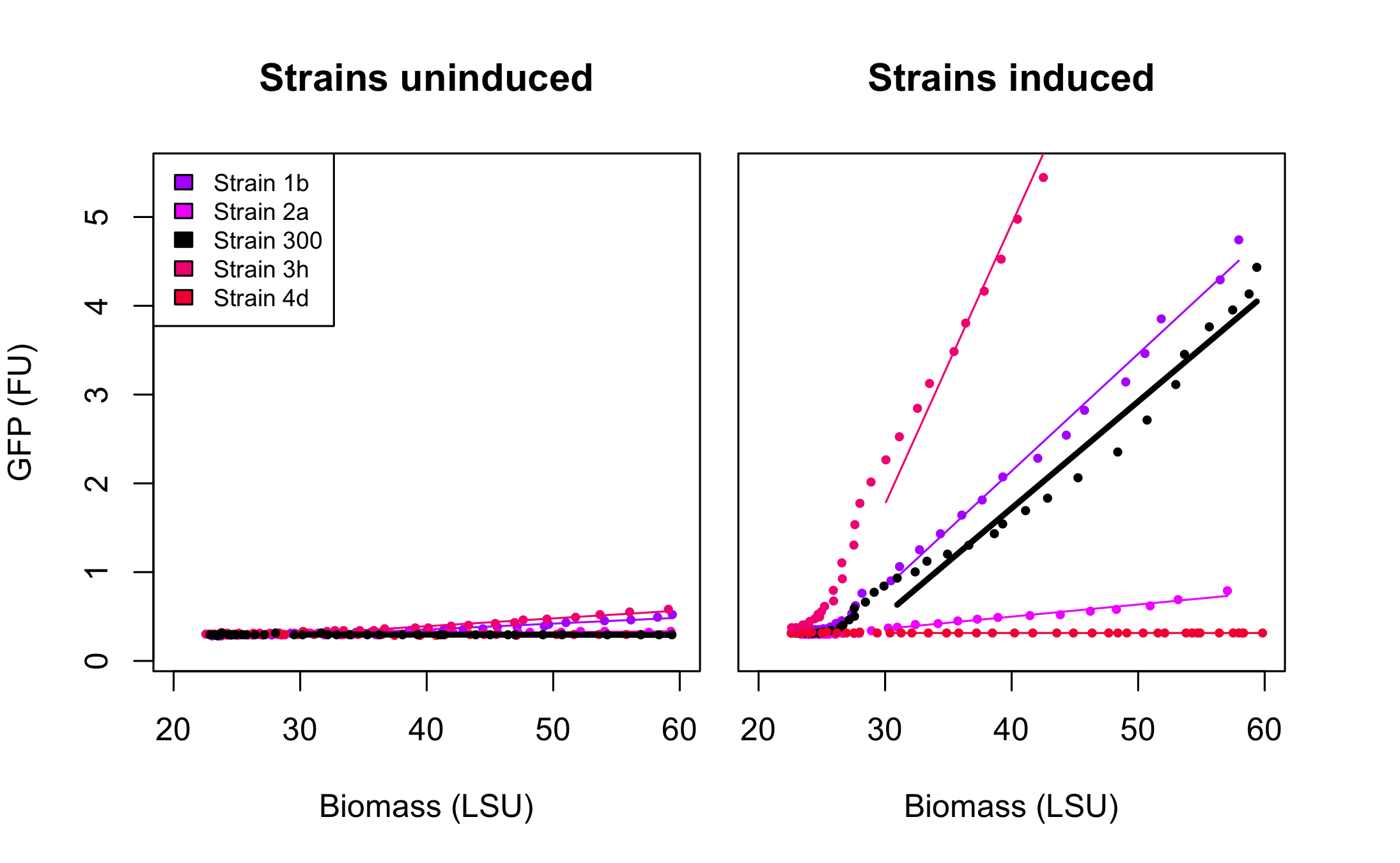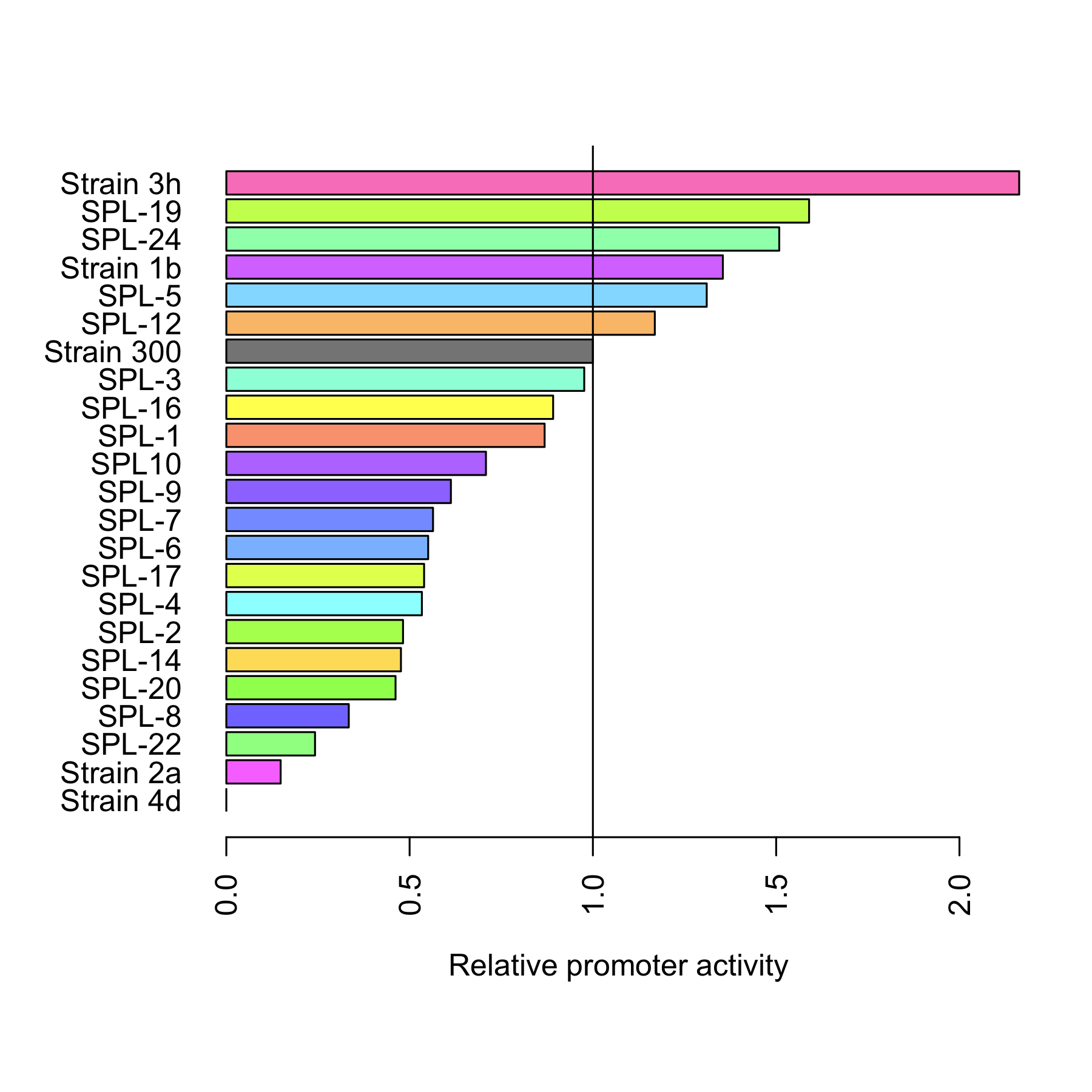Team:DTU-Denmark/Project improving araBAD
From 2011.igem.org
(Created page with "{{:Team:DTU-Denmark/Templates/Standard_page_begin|Experiment: Improving araBAD}} {{:Team:DTU-Denmark/Templates/Standard_page_end}}") |
|||
| Line 1: | Line 1: | ||
{{:Team:DTU-Denmark/Templates/Standard_page_begin|Experiment: Improving araBAD}} | {{:Team:DTU-Denmark/Templates/Standard_page_begin|Experiment: Improving araBAD}} | ||
| + | |||
| + | == ''araBAD'' promoter == | ||
| + | |||
| + | In our project to control sRNA chiXR expression we used the arabinose promoter (P<span class="subscript">BAD</span>) from the ''araBAD'' operon that is regulated by araC protein<span class="superscript">[[#References|[10]]]</span>. AraC can work both as a repressor and activator of the PBAD and the mode of action depends on the presence of arabinose. P<span class="subscript">BAD</span> promoter becomes activated in the presence of arabinose and repressed when arabinose is unavailable. | ||
| + | |||
| + | Choice of P<span class="subscript">BAD</span> was not accidental. AraC repression in the absence of arabinose provides a very low level of background expression which can be lowered even more by adding glucose (catabolic repression). Once induced, this promoter allows a moderate level of expression. Finally, a range of arabinose concentrations can be used to achieve a desired level of induction<span class="superscript">[[#References|[7]]]</span><span class="superscript">[[#References|[10]]]</span>. | ||
| + | |||
| + | There are however some known issues with P<span class="subscript">BAD</span> promoter. Heterogeneous induction, known also as “all-or-nothing”<span class="superscript">[[#References|[6]]]</span> induction of cell culture is one of them. As a result only a subset of cells becomes induced with the arabinose. To circumvent “all-or-nothing” problem the arabinose transporter (AraE) could be placed under inducible promoter<span class="superscript">[[#References|[7]]]</span> or a different transporter could be engineered to have affinity to arabinose, e.g. LacY<span class="superscript">[[#References|[11]]]</span>, and facilitates its uptake. Another problem arises when one wants to use P<span class="subscript">BAD</span> promoter along with another promoter, e.g. P<span class="subscript">prpB</span> promoter from propionate operon, and achieve a similar level of induction from both of them. This might not be feasible as P<span class="subscript">BAD</span> is considerably weaker in expression than aforementioned PprpB promoter<span class="superscript">[[#References|[8]]]</span><span class="superscript">[[#References|[10]]]</span>. | ||
| + | |||
| + | == Approach == | ||
| + | |||
| + | Since control of the system is essential to the applicability of our system we attempted to modify the dynamic range of the arabinose promoter ([http://partsregistry.org/Part:BBa_I0500 BBa_I0500]) by two means: | ||
| + | *rationally designing the -10 and -35 sequences of the promoter region since both the -35 (CTGACG) and the -10 (TACTGT) of the arabinose promoter are far from wild-type (TTGACA and TATAAT respectively). | ||
| + | *changing the nucleotides around and between the -10 and the -35 using synthetic promoter library (SPL), without changing the -10 and -35 from wildtype. | ||
| + | |||
| + | The arabinose promoter we were improving was fused to GFP and this construct came as a biobrick [http://partsregistry.org/Part:BBa_I746908 BBa_I746908]. To introduce the changes a set of primers was used to PCR P<sub>BAD</sub>. Four primers, SRS56 from 1 to 4, were used to make PCR products with mutated nucleotides within -10 and -35 and SRS56SPL primer was used to make the SPL PCR products. Then a round of restriction digestions and ligations followed which allowed to exchange the wild type P<sub>BAD</sub> with the mutated ones. Then they were transformed into E. coli strain DH5$\alpha$. Finally, all the rationally changed P<sub>BAD</sub> promoters and randomly selected SPL mutants were characterized using Biolektor. | ||
| + | |||
| + | Detailed description of the experiments, including information on primers used, can be found in [https://2011.igem.org/Team:DTU-Denmark/Technical_stuff_lab labnotebook]. | ||
| + | |||
| + | [[File:DTU1_Arabinose_promoter_zoom.png|665px|thumb|right|add some text]] | ||
| + | [[File:DTU1_Arabinose_promoter.png|665px|thumb|right|add some text]] | ||
| + | |||
| + | == Results == | ||
| + | |||
| + | All 4 rationally designed (called Strain 1b, 2a, 3h, 4d) and 18 SPL-changed arabinose promoters (called SPL-1 up to SPL-24) fused to GFP were tested under induction of arabinose at concentration 0.2% and compared to non-induced state. Also, the original [http://partsregistry.org/Part:BBa_I746908 BBa_I746908], named Strain 300, was characterized in the same fashion. In all the figures the GFP expression and the biomass concentration are expressed in fluorescence unit (FU) and light scattering unit (LSU) respectively. | ||
| + | |||
| + | Figure 1 presents the characterization for the rationally designed arabinose promoters. When uninduced (left part of the figure) the background GFP expression level for strains 1b and 3h is slightly above the background in original promoter (black line) which indicates that these promoters are less tight. In case of strains 2a and 4d the basal expression level is comparable to the original promoter. From the right part of the figure we can see that the induction didn't influence expression in strain 4d which implies that mutations abolished arabinose regulation in that promoter. In case of strain 2a induction is maintained, however its level is much lower than that of original promoter. | ||
| + | |||
| + | [[File:DTU-Strains_uninduced.GFPvsBiomass_v4.png|665px|thumb|center|add some text]] | ||
| + | |||
| + | [[Image:DTU-SPL_uninduced.GFPvsBiomass_v4.png|665px|thumb|center|add some text]] | ||
| + | |||
| + | [[Image:DTU-Relative_promoter_activity.png|665px|thumb|center|add some text]] | ||
| + | <html></div><div class="whitebox article"></html> | ||
| + | |||
| + | ==References== | ||
| + | [1] Datta, Simanti, Nina Costantino, and Donald L Court. “A set of recombineering plasmids for gram-negative bacteria.” Gene 379 (September 1, 2006): 109-15. http://www.ncbi.nlm.nih.gov/pubmed/16750601. | ||
| + | |||
| + | [2] Figueroa-Bossi, Nara, Martina Valentini, Laurette Malleret, and Lionello Bossi. “Caught at its own game: regulatory small RNA inactivated by an inducible transcript mimicking its target.” Genes & Development 23, no. 17 (2009): 2004 -2015. | ||
| + | |||
| + | [3] Hayashi, Koji, Naoki Morooka, Yoshihiro Yamamoto, Katsutoshi Fujita, Katsumi Isono, Sunju Choi, Eiichi Ohtsubo, et al. “Highly accurate genome sequences of Escherichia coli K-12 strains MG1655 and W3110.” Molecular Systems Biology 2 (2006): 2006.0007. http://www.ncbi.nlm.nih.gov/pubmed/16738553. | ||
| + | |||
| + | [4] Lambert, Jolanda M, Roger S Bongers, and Michiel Kleerebezem. “Cre-lox-based system for multiple gene deletions and selectable-marker removal in Lactobacillus plantarum.” Applied and environmental microbiology 73, no. 4 (February 2007): 1126-35. http://www.pubmedcentral.nih.gov/articlerender.fcgi?artid=1828656&tool=pmcentrez&rendertype=abstract. | ||
| + | |||
| + | [5] Overgaard, Martin, Jesper Johansen, Jakob Møller‐Jensen, and Poul Valentin‐Hansen. “Switching off small RNA regulation with trap‐mRNA.” Molecular Microbiology 73, no. 5 (September 2009): 790-800. | ||
| + | |||
| + | [6] Novick, A. & Weiner, M. “Enzyme induction as an all-or-none phenomenon“ Proc. Natl. Acad. Sci. USA 43 (1957), 533–556. | ||
| + | |||
| + | [7] Khlebnikov, A., K. Datsenko, T. Skaug, B. L. Wanner, and J. D. Keasling. “Homogeneous expression of the P(BAD) promoter in Escherichia coli by constitutive expression of the low-affinity high-capacity AraE transporter.” Microbiology (Reading, England) 147, no. Pt 12 (December 2001): 3241-7. http://www.ncbi.nlm.nih.gov/pubmed/11739756. | ||
| + | |||
| + | [8] Lee, Sung Kuk, and Jay D Keasling. “A Propionate-Inducible Expression System for Enteric Bacteria.” Society 71, no. 11 (2005): 6856-6862. | ||
| + | |||
| + | [9] Lee, Sung Kuk, and Jay D Keasling. “Propionate-Regulated High-Yield Protein Production in Escherichia coli.” Biotechnology (2005). | ||
| + | |||
| + | [10] Guzman, L M, D Belin, M J Carson, and J Beckwith. “Tight regulation, modulation, and high-level expression by vectors containing the arabinose PBAD promoter.” Journal of bacteriology 177, no. 14 (July 1995): 4121-30. http://www.pubmedcentral.nih.gov/articlerender.fcgi?artid=177145&tool=pmcentrez&rendertype=abstract. | ||
| + | |||
| + | [11] Morgan-Kiss, Rachael M, Caryn Wadler, and John E Cronan. “Long-term and homogeneous regulation of the Escherichia coli araBAD promoter by use of a lactose transporter of relaxed specificity.” Proceedings of the National Academy of Sciences of the United States of America 99, no. 11 (May 28, 2002): 7373-7. http://www.pubmedcentral.nih.gov/articlerender.fcgi?artid=124238&tool=pmcentrez&rendertype=abstract. | ||
| + | |||
| + | [12] Rasmussen, Anders Aamann, Jesper Johansen, Jesper S Nielsen, Martin Overgaard, Birgitte Kallipolitis, and Poul Valentin‐Hansen. “A conserved small RNA promotes silencing of the outer membrane protein YbfM.” Molecular Microbiology 72, no. 3 (May 2009): 566-577. | ||
{{:Team:DTU-Denmark/Templates/Standard_page_end}} | {{:Team:DTU-Denmark/Templates/Standard_page_end}} | ||
Revision as of 21:16, 21 September 2011
Experiment: Improving araBAD
Contents |
araBAD promoter
In our project to control sRNA chiXR expression we used the arabinose promoter (PBAD) from the araBAD operon that is regulated by araC protein[10]. AraC can work both as a repressor and activator of the PBAD and the mode of action depends on the presence of arabinose. PBAD promoter becomes activated in the presence of arabinose and repressed when arabinose is unavailable.
Choice of PBAD was not accidental. AraC repression in the absence of arabinose provides a very low level of background expression which can be lowered even more by adding glucose (catabolic repression). Once induced, this promoter allows a moderate level of expression. Finally, a range of arabinose concentrations can be used to achieve a desired level of induction[7][10].
There are however some known issues with PBAD promoter. Heterogeneous induction, known also as “all-or-nothing”[6] induction of cell culture is one of them. As a result only a subset of cells becomes induced with the arabinose. To circumvent “all-or-nothing” problem the arabinose transporter (AraE) could be placed under inducible promoter[7] or a different transporter could be engineered to have affinity to arabinose, e.g. LacY[11], and facilitates its uptake. Another problem arises when one wants to use PBAD promoter along with another promoter, e.g. PprpB promoter from propionate operon, and achieve a similar level of induction from both of them. This might not be feasible as PBAD is considerably weaker in expression than aforementioned PprpB promoter[8][10].
Approach
Since control of the system is essential to the applicability of our system we attempted to modify the dynamic range of the arabinose promoter ([http://partsregistry.org/Part:BBa_I0500 BBa_I0500]) by two means:
- rationally designing the -10 and -35 sequences of the promoter region since both the -35 (CTGACG) and the -10 (TACTGT) of the arabinose promoter are far from wild-type (TTGACA and TATAAT respectively).
- changing the nucleotides around and between the -10 and the -35 using synthetic promoter library (SPL), without changing the -10 and -35 from wildtype.
The arabinose promoter we were improving was fused to GFP and this construct came as a biobrick [http://partsregistry.org/Part:BBa_I746908 BBa_I746908]. To introduce the changes a set of primers was used to PCR PBAD. Four primers, SRS56 from 1 to 4, were used to make PCR products with mutated nucleotides within -10 and -35 and SRS56SPL primer was used to make the SPL PCR products. Then a round of restriction digestions and ligations followed which allowed to exchange the wild type PBAD with the mutated ones. Then they were transformed into E. coli strain DH5$\alpha$. Finally, all the rationally changed PBAD promoters and randomly selected SPL mutants were characterized using Biolektor.
Detailed description of the experiments, including information on primers used, can be found in labnotebook.
Results
All 4 rationally designed (called Strain 1b, 2a, 3h, 4d) and 18 SPL-changed arabinose promoters (called SPL-1 up to SPL-24) fused to GFP were tested under induction of arabinose at concentration 0.2% and compared to non-induced state. Also, the original [http://partsregistry.org/Part:BBa_I746908 BBa_I746908], named Strain 300, was characterized in the same fashion. In all the figures the GFP expression and the biomass concentration are expressed in fluorescence unit (FU) and light scattering unit (LSU) respectively.
Figure 1 presents the characterization for the rationally designed arabinose promoters. When uninduced (left part of the figure) the background GFP expression level for strains 1b and 3h is slightly above the background in original promoter (black line) which indicates that these promoters are less tight. In case of strains 2a and 4d the basal expression level is comparable to the original promoter. From the right part of the figure we can see that the induction didn't influence expression in strain 4d which implies that mutations abolished arabinose regulation in that promoter. In case of strain 2a induction is maintained, however its level is much lower than that of original promoter.
References
[1] Datta, Simanti, Nina Costantino, and Donald L Court. “A set of recombineering plasmids for gram-negative bacteria.” Gene 379 (September 1, 2006): 109-15. http://www.ncbi.nlm.nih.gov/pubmed/16750601.
[2] Figueroa-Bossi, Nara, Martina Valentini, Laurette Malleret, and Lionello Bossi. “Caught at its own game: regulatory small RNA inactivated by an inducible transcript mimicking its target.” Genes & Development 23, no. 17 (2009): 2004 -2015.
[3] Hayashi, Koji, Naoki Morooka, Yoshihiro Yamamoto, Katsutoshi Fujita, Katsumi Isono, Sunju Choi, Eiichi Ohtsubo, et al. “Highly accurate genome sequences of Escherichia coli K-12 strains MG1655 and W3110.” Molecular Systems Biology 2 (2006): 2006.0007. http://www.ncbi.nlm.nih.gov/pubmed/16738553.
[4] Lambert, Jolanda M, Roger S Bongers, and Michiel Kleerebezem. “Cre-lox-based system for multiple gene deletions and selectable-marker removal in Lactobacillus plantarum.” Applied and environmental microbiology 73, no. 4 (February 2007): 1126-35. http://www.pubmedcentral.nih.gov/articlerender.fcgi?artid=1828656&tool=pmcentrez&rendertype=abstract.
[5] Overgaard, Martin, Jesper Johansen, Jakob Møller‐Jensen, and Poul Valentin‐Hansen. “Switching off small RNA regulation with trap‐mRNA.” Molecular Microbiology 73, no. 5 (September 2009): 790-800.
[6] Novick, A. & Weiner, M. “Enzyme induction as an all-or-none phenomenon“ Proc. Natl. Acad. Sci. USA 43 (1957), 533–556.
[7] Khlebnikov, A., K. Datsenko, T. Skaug, B. L. Wanner, and J. D. Keasling. “Homogeneous expression of the P(BAD) promoter in Escherichia coli by constitutive expression of the low-affinity high-capacity AraE transporter.” Microbiology (Reading, England) 147, no. Pt 12 (December 2001): 3241-7. http://www.ncbi.nlm.nih.gov/pubmed/11739756.
[8] Lee, Sung Kuk, and Jay D Keasling. “A Propionate-Inducible Expression System for Enteric Bacteria.” Society 71, no. 11 (2005): 6856-6862.
[9] Lee, Sung Kuk, and Jay D Keasling. “Propionate-Regulated High-Yield Protein Production in Escherichia coli.” Biotechnology (2005).
[10] Guzman, L M, D Belin, M J Carson, and J Beckwith. “Tight regulation, modulation, and high-level expression by vectors containing the arabinose PBAD promoter.” Journal of bacteriology 177, no. 14 (July 1995): 4121-30. http://www.pubmedcentral.nih.gov/articlerender.fcgi?artid=177145&tool=pmcentrez&rendertype=abstract.
[11] Morgan-Kiss, Rachael M, Caryn Wadler, and John E Cronan. “Long-term and homogeneous regulation of the Escherichia coli araBAD promoter by use of a lactose transporter of relaxed specificity.” Proceedings of the National Academy of Sciences of the United States of America 99, no. 11 (May 28, 2002): 7373-7. http://www.pubmedcentral.nih.gov/articlerender.fcgi?artid=124238&tool=pmcentrez&rendertype=abstract.
[12] Rasmussen, Anders Aamann, Jesper Johansen, Jesper S Nielsen, Martin Overgaard, Birgitte Kallipolitis, and Poul Valentin‐Hansen. “A conserved small RNA promotes silencing of the outer membrane protein YbfM.” Molecular Microbiology 72, no. 3 (May 2009): 566-577.
 "
"













